Help with Monstera adansonii
Couldn't resist bringing home this beautiful Monstera adansonii/Swiss cheese vine from my local garden center the other day! This is my first plant that requires higher humidity and I want to make sure I take care of it properly. It's currently outside where it can soak up our humid summer air but I will be taking it inside by a bright window with indirect light. A couple questions:
1. As you can see the plant is quite pot-bound and some roots are bursting out of the pot. Should I trim these roots when planting in its new pot?
2. Other than a pebble tray, how can I be sure to give this plant the humidity it needs? If misting, which part of the plant should I mist? Any tips on how to do this without soaking everything around it? (The pot will be too heavy for me to realistically move every time it needs to be watered).
2. What type of soil should I use? I currently have regular Coast of Maine potting soil (http://coastofmaine.com/product/barharbor/). But in researching the plant I read that it should have "A very well-drained potting mix, including plenty of perlite." (source: http://houseplants.about.com/od/foliageplants/p/Swiss-Cheese-Plant-How-To-Monstera-Adansonii.htm). Does this sound accurate to growers of this pretty plant? How much is "plenty of" perlite?
Any other tips from adansonii growers? Thanks in advance!

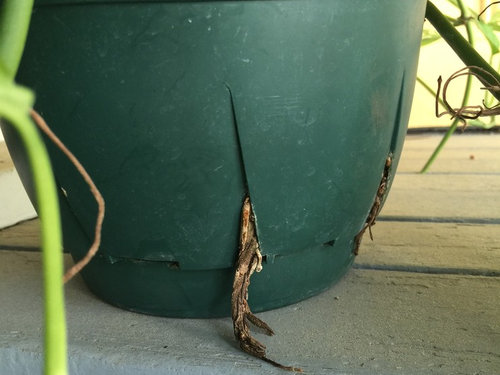

Comments (102)
Russ1023 (central Fla)
7 years agoMarlene, yes, having to water every day shouldn't be necessary. If the mix dries out that fast, I'd repot into something else.
I would think a pot of 'gritty mix' would be dry after 5 or 6 days. How big was the pot and what were the ingredients of the mix? I assume bark, granite and a calcined clay product like Turface, all sifted.
I'm not a fan of Turface and products like it. I've had a lot of my succulent collection in variously proportioned mixes with Turface, some nearly identical to 'gritty', and rotting roots has been a serious problem. I've been repotting back into mixes without it for quite awhile. The humidity here in Florida is always high, maybe calcined clay works better in a drier climate.
I'm not saying that the calcined clay in the mix is your problem. Obviously if there was standing water in the bottom of the succulent pot after 5-6 days, it didn't drain well enough and the calcined clay couldn't absorb that much water. Do these pots have drainage holes that seem adequately large?
Russ
Russ1023 (central Fla)
7 years agoTiffany, your post came in just before mine. I'm still puzzled by Marlene's comment about the succulent pot of 'gritty' that was still very wet after having been watered 5 or 6 days prior. This obviously isn't overwatering, so I don't get it. I do get what you're saying about folks that switch to the more open mixes and then have trouble with timing their watering. I think this is more of a problem when folks switch to the 'gritty mix' than it is with standard mixes simply made more open with chunkier ingredients.
You always give very sensible advice and you have the experience with the 'gritty mix' to advise Marlene correctly. I have difficulty relating since I'm not on board with the mix or the concept as it applies to tropicals.
Have you switched to 'gritty' for all your plants including tropicals? What about all the sifting of ingredients that seems to be required?
Russ
Related Discussions
Help with monstera Adansonii
Q
Comments (6)Something like you would use for an epiphytic orchid would be good. The main thing is to have a 'generous' amount of breathing holes around the roots. That's something that ordinary potting mix wouldn't give you.Just remember that in time the organic component of the mix will break down and the remaining soil will become compacted. That would be a good time for repotting again....See MoreI'm looking to buy a Monstera Adansonii Archipelago variegated or trad
Q
Comments (3)I have it its in a 4 inch pot, what do you have thats are rare plants...See MoreMonstera Adansonii: Nutrient Deficiency?
Q
Comments (3)Hi there. I have two of these plants. One's pretty healthy and the other is a bit of a big box store rescue. When I first got the rescue, the soil was soaking wet. I put it in sunlight and the leaves turned a yellowish speckled color, similar to your first picture. It's doing okay but it's not put out any new leaves. Also, I just noticed that my healthy plant has a leaf or two, closest to the soil, with some yellowish speckles (see 2nd picture) but I don't remember if it was like that when I got it. It puts out new leaves regularly and they look pretty similar to your new growth leaves, just with a few more fenestrations. Hope this helps some and I hope your plant is a-ok....See MoreMonstera Adansonii dark green spots
Q
Comments (3)I'm pretty sure that's the problem. Let me add that all fertilizers are not created equal. Foliage-Pro 9-3-6 is a superb fertilizer for close to all of the plants houseplant care givers are likely to grow. It has all nutrients essential to normal growth (few soluble synthetic fertilizers can make that claim), in a ratio that favors your plant, and it doesn't get it's N from urea - an attribute that helps keep you plant full and more compact. It's the only product you would need to cover the full spectrum of essential nutrients; and, it's worth the wait as you'll likely find you'll need to order from an online source. Please come back a couple of weeks after you fertilize and let us know how you've fared. Al...See MoreLauren (Zone 9a)
7 years agoIf the mix is unbalanced, all the small particles can fall to the bottom. In that case, the mix can stay wet for many days. Add to this, one may keep watering because it feels dry in the top half.
Marlene, if I may, perhaps the mix wasn't sufficiently mixed, or perhaps there is, as you suggest, some imbalance. My first gritty mixes were disasters because I didn't realize how much mixing was involved, and because the particles were not the same size. Consequently, all the perlite and soil collected at the bottom.
I think also that very good drainage is critical. If you did have smaller particles at the bottom, good drainage holes would ensure that they do not collect and block the drainage holes.
if it is still wet, that is probably what has happened. You may want to insert a wick at the bottom for now to help it drain. Your pot is cone shaped so the particles can easily collect in the smaller bottom.
I would bet that if you take the plant out you will find a pretty soggy bottom.
I don't know if a repotting is in order, but you may find that the mix is not going to work as it is. There is a bit of a learning curve with the gritty mix. I understand what you mean about not knowing when to water it. But if it was prepared correctly, the water would flow through, and the plant would not still be wet, and you could water freely without fear of overwatering.
As an immediate step towards remedy, I would definitely insert a wick. Perhaps others will come along and help you work through the potential problems with your mix and tell you how to fix it. They may also be more knowledgable than I about whether you should go ahead and try to repot the plant. Personally, I would take it out and look at the mix and see if it needs to be adjusted.
I hope this helps, and I hope others can chime in to offer more detailed and useful advice about your gritty mix.
Tiffany, purpleinopp Z8b Opp, AL
7 years agoRuss, I'm way too lazy & impulsive to follow a recipe so I try to make that clear when discussing these things, like using references to *a* gritty or more chunky mix and from your question it sounds like I've failed to do that here, so TY for asking. I have taken the general principles about texture/particle size and moisture retention and tried to apply them in my own lazy way. I don't have the background experience to discuss them in specific detail.
And say, for example, 10 people read & execute the same instructions. The result will be 10 slightly diff things. For any pot that's not too heavy, picking it up has always been my best gauge for determining if significant drying has occurred, when that's been important to know.
Russ1023 (central Fla)
7 years agoTiffany, you're a grower after my own heart! I've never followed a soil recipe exactly in my life, I'm more likely to change it based on my personal experience than follow it to the letter. I'm always experimenting with so-called recipes, proportions and ingredients. I've seen many recipes become popular for a decade or so and then disappear when the next 'better mix' comes on the scene.
I agree about your example of 10 people coming up with 10 slightly different mixes from the same recipe. And due to most plants being very adaptable to soil mixes, all those variations of the recipe will grow excellent plants as long as the watering is done halfway right.
I like your comment about 'general principles'.
Yes, experience is a good teacher regarding the weight of a pot when it's dry or well watered. That's why I encourage experimentation to newbies rather than following someone's exact method of growing, soil mix recipes, etc. Growing conditions, climates, habits and opinions always vary, so there's no substitute for gaining experience by trial and error.
Russ
Marlene (Zone 6b Boston, MA)
Original Author7 years agoHi, all, I'm still here! Thank you for continuing this conversation and offering so much insight. I'll try to address all the different points brought up.
About the mix I'm using: It is a store-bought gritty mix from Bonsai Jack that is supposedly pre-sifted (http://www.bonsaijack.com/succulent_soil_111_gritty_mix.html).
Ingredients: 33% 1/4 Pine Bark Fines, 33% 1/4 Bonsai Block(calcined clay) and 33% Monto Clay(1/4 inch Turface)
Average Particle Size: ¼ Inch
Minimum Size: 1/8th Maximum Size: 3/8ths
Here is a picture of the mix:

Lauren, the pot with the Monstera a. has a large drainage hole, but it is as you pointed out cone-shaped. Do you think, based on the photo of the mix, that the particle size is too variable?
Update on the Monstera a: No new yellow leaves since my last writing! That's 5 days, woo! However, there are some leaves that have developed yellow on the tip with brown:



Lauren, what is a wick?Tiffany, I feel like I need to keep hearing it because I am, as you say, stuck in my soil-based watering habits -- I only should water when the dowel comes out dry at the root level, yes?
About the succulent that was still wet at the bottom: I sold the plant in question, but after seeing Russ's comment about the hole size I took another look at the pot and realized the drainage hole on that one is quite small. Lesson learned.
I feel like I am definitely having more trouble with *this* gritty mix than I expected to. However, I have a second succulent that seems to have recovered quite nicely and looks good now since I repotted into that mix (I did a few plants all at once). Perhaps some of what I was seeing was transplant shock, combined with the roots being in water...I hope?
Marlene (Zone 6b Boston, MA)
Original Author7 years agoForgot to add, to keep the mix from pouring out of the bottom of the pot, I have a piece of drywall tape over the hole, it looks like this:
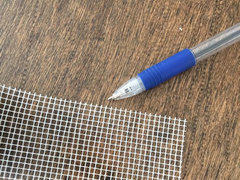
Russ1023 (central Fla)
7 years agoGood idea Marlene. I've used pieces of window screening in the past. I also sometimes throw an inch of chunky pine bark mulch in the bottom of the pot when repotting.
The heavy one-gallon nursery pots I use often have huge drain holes since they originally contained trees, shrubs or other landscape material planted in chunky pine bark mixes.
Russ
Russ1023 (central Fla)
7 years agoMarlene, I should have explained. The chunky pine bark mulch in the bottom of the pot acts as a filter so the soil mix doesn't run out of the drain holes. Pea gravel would do the same thing but it would be much heavier. Obviously a piece of some kind of screen is the simplest solution, if one has it around the house.
Russ
Marlene (Zone 6b Boston, MA)
Original Author7 years agoThanks, Russ! That makes sense. Can I ask what you make of the yellow and brown leaf tips on this plant? Today it also looks a little lighter green all over. Is it possibly it's just not receiving enough light? It's right next to a southwest facing window so I thought it would be ok.
Marlene (Zone 6b Boston, MA)
Original Author7 years agoSorry to just keep having more and more questions, I feel like I'm losing my mind over this plant!
- Marlene (Zone 6b Boston, MA) thanked Tiffany, purpleinopp Z8b Opp, AL
Lauren (Zone 9a)
7 years agoMarlene, have you checked the bottom to make sure there isn't a collection of particles and water there?
Jaycee
7 years agoI don't have anything useful to add, but wanted to say the plant looks beautiful and I'm rooting (har har) for a quick recovery!
Marlene (Zone 6b Boston, MA) thanked JayceeRuss1023 (central Fla)
7 years agoMarlene, I wouldn't worry about the yellow or brown leaf tips, could be any number of reasons causing it including the leaf simply getting old, chemicals in your household water, etc. As long as you're waiting for the top inch or two of soil to dry, and no earlier or too much longer than that, you're good. Give it a couple of weeks and see how it goes. I doubt lack of light would cause the yellowing, it would cause 'stretching', more distance beween leaves on the vine.
No problems on the questions, everyone is here for you. We want you to be successful in growing your plants. Keep us posted.
Russ
Marlene (Zone 6b Boston, MA) thanked Russ1023 (central Fla)Marlene (Zone 6b Boston, MA)
Original Author7 years agolast modified: 7 years agoLauren: No, I haven't checked the bottom. I just watered again today so I will do that before the next watering. Since there is a piece of screen covering the hole from the inside of the pot, I'm not sure how easily I'll be able to check.
Russ: No new yellowing leaves or leaf tips since last week! Hoping that the plant is all done with its pouting now. Also I wanted to ask you, I know you said you aren't on the "gritt/5-1-1" mix train, especially for tropicals. What do you like to use instead? I feel like the science of it makes a lot of sense to me, but I'm not sure I can imagine watering all of my plants so frequently. The only way I can tell when I need to water this particular plant is when it's looking wilty, as I can't get a dowel down into the pot. I don't like having the plant be stressed by too infrequent watering (currently around every 4 days). So, what is your own preferred soil mix, especially for tropicals? And, I can tell you're an experienced grower; do your tropicals live for years? One of the reasons I was drawn to the gritty mix discussions is that I've had a lot of plants die on me in the last few years, in spite of being very careful about root rot in regular store-bought potting soil. (I know there's a lot of other variables too, but I generally try to only put plants that will get adequate light in my house. Another variable -- I never fertilized anything).
Lauren (Zone 9a)
7 years agoMarlene,
you really should be able to use a skewer to test for wetness. That's is, I believe, critical. So, perhaps you could try a thinner skewer? Or, you can force one down the side of the plant where there are no roots. The materials shouldn't be so dense that you can't get a skewer in there.
sorry to sound like a broken record, but I really, really think that you need to be able to know what's going on down below. I think water and fine particles can collect at the bottom of that pot, which is now doubly clogged because there is a screen blocking the single exit hole. This would mean that it would not drain as freely as the mix should.
If everything looks good, then feel free to disregard my comments about the drainage. But I maintain that at the very least, you should be able to get the skewer in the mix.
Marlene (Zone 6b Boston, MA) thanked Lauren (Zone 9a)Russ1023 (central Fla)
7 years agoHi Marlene, I've said I reject any kind of 'gritty mix' for tropicals, but the so-called 5-1-1 is at least bark, peat and perlite, normal ingredients for tropicals. However, sifting for particles too small and too large, the waste involved and the required soaking of bark, then having to water so often... this isn't a mix I'd make or use, or even recommend. There are some that think it's great and as I've always said, whatever works, stay with it. But I'm not going there.
I grow exclusively outdoors, except for winter when some plants are indoors temporarily during short cold spells.
Over years of experimenting with mixes I've generally settled on the following basic ingredients... pine bark mulch, peat moss or any of the peat-based commercial mixes , coarse perlite or small styrofoam balls, and occasionally fine or coarse vermiculite. Walmart in my area carries a pine bark mulch product that works well, $3.44 in 2 cubic foot bags. My 'measurement' is usually a big handful or a little handful depending on the size of the bucket I'm mixing in. Very loosely... 4 to 6 parts bark, 1 to 2 peat or commercial mix, 1 to 2 perlite or styrofoam. If I add vermiculite, 1 part. No sifting. As with most other mixes including commercial types, when the top 1 or 2 inches is dry, you water. All the groups of plants I grow like this mix with some minor fiddling with proportions.
Russ
Marlene (Zone 6b Boston, MA)
Original Author7 years agoLauren, I sharpened the tip of the skewer more and was able to get it further into the pot. Upon pulling it out, it is barely damp, even though I watered sufficiently (flushing the soil) just yesterday. I just felt the drainage hole as much as I could with the tip of the finger and it is still wet. Do you not use a screen to cover the drainage hole on your pots? If not, how do you keep the mix from falling out the bottom? I'm very worried about disturbing the plant again by pulling it out, but if that's really what you recommend I could give it a try. What planting mix do you use?
Russ, your mix does sound much easier in practice. And you must live in a nice warm area being able to grow your plants outdoors for so long! What kind of plants do you grow? And how do you determine when a plant needs "fiddling with proportions?" I don't want to have plants die on me anymore!
Marlene (Zone 6b Boston, MA)
Original Author7 years agoAlso, when you say "pine bark mulch" do you mean mulch or nuggets? Do you happen to know the brand name of the kind you use?
Lauren (Zone 9a)
7 years agohi Marlene :) I'm really glad you were able to get the skewer in there. It's weird that it's barely damp, but the bottom at the drainage hole is wet. I can understand not wanting to disturb the plant again. If you feel comfortable with it right now, perhaps you can worry about the bottom drainage much later when the roots begin to reach that part of the pot.
I don't put anything at the bottom. I just put in the mix, and the combo of the materials is enough to keep it from coming out of the bottom. When I first water it in, sometimes particles come out, and every now and then a piece may fall out, but it pretty much stays put.
Btw, i think you and I and Russ had a quick talk about this on another thread, but I wanted to tell you: I finally got my hands on some black gold cactus and succulent mix, and i love it. It has no peat whatsoever and it drains beautifully. It is bark, pumice, perlite, lime, and crushed bark material. It's like the other potting soil I showed you but without the peat!
But the mix you are using takes a moment to start really working for the plants. When the roots get comfortable and everything settles, the monstera will start growing wonderfully. I've found that it takes some time, and then one day, the plant just starts looking really great and putting out new leaves.
The watering learning curve was steep for me as well. I wish I could advise you better on this, but I just don't have the knowledge. I'm still learning, too.
But Russ and Al won't steer you wrong, so you are in good hands.
Marlene (Zone 6b Boston, MA) thanked Lauren (Zone 9a)Russ1023 (central Fla)
7 years agoMarlene, the product I buy at Walmart is pine bark mulch, not nuggets. The brand is Timberline, purple bag with big black center with white letters 'Pine Bark Mulch'. Timberline also sells nuggets and mini-nuggets. I wouldn't be surprised if Timberline isn't available in Boston, but maybe something similar. Just look for 'pine bark mulch' at Walmart, Lowe's or Home Depot. It contains small particles, shreds and pieces of pine bark, but not chunks.
I live in central Florida, so summers are hot and humid, winters can have a few night temps just below freezing which does present a problem with outside plants. I have a big covered shadehouse that houses a few hundred rare and special plants in winter but it's not heated.
I have many hundreds of aroids, mostly philodendrons, aglaonemas and dieffenbachias. I also have a large collection of sansevierias aka snake plants as well as quite a few succulents, hoyas and crotons.
By 'fiddling with proportions' I mean that if a plant likes to be more moist at the roots, I add an extra part of peat moss or peat-based commercial mix, or an extra part of vermiculite which holds a little more moisture. If a plant likes better drainage and to dry out quicker, I add more perlite, styrofoam balls or another aggregate.
What potting mixes have you used that you've lost plants in? Many times it's simply not knowing the correct watering methods rather than the mix you're using. That said, the 511 and gritty mix crowd do praise the mixes for being hard to overwater a plant that's in them. Tiffany spoke to this in posts above. Tiffany or Al would be the best ones to get advice from on these mixes since I don't use them.
You might consider taking cuttings from your monstera and trying several pieces each in pots of various soil mixes to see which ones grow best. It might be a learning experience and it would also give you backup plants in case something happens to your big one.
If you will email me your address, I'll send you a large sample of my bark mix for you to try. I can also send some small bags of a few commercial mixes I have in my shed if you'd like.
bluesea14808@yahoo.com
Russ
Lauren (Zone 9a)
7 years agoHi Russ,
not sure if you saw what I wrote above, but the new potting soil is rather nice:). I know you like experimenting, so thought you might be interested.
L
Russ1023 (central Fla)
7 years agoHi Lauren, your Black Gold C&S mix does sound good. Many C&S growers hate peat moss in their mixes, I think it's okay in very small amounts. I wonder if the 'crushed bark material' you mentioned is fine enough that it acts as a peat substitute, some folks might have a problem with that. I'd probably rather have that than peat moss in the mix. But the pumice is a major plus, I've only seen it once when a friend sent me a bag of it years ago. Wish I could remember who that was, pretty sure I forgot to thank them for it and it has bothered me ever since.
I don't think Black Gold is sold in my area, but I'll look for it. Did you mail order it or find it locally wherever you are? Be sure to let us know how it works for you.
Russ
Lauren (Zone 9a)
7 years agoHi Russ: the crushed bark material does not impede drainage even a little bit like peat does. Water flows through this soil immediately.
To be honest, I bought it for the pumice. I can't find it around here, so I thought the next best thing would be a mix with pumice. And I totally lucked out because this mix is full of pumice. I think that may be the primary ingredient actually.
I am loving this pumice, too. It's so much nicer than perlite.
I ordered it from my local ace hardware. He said they have tons in stock in the warehouse. It was 5.99. But, then, on Sunday, I took a trip to my favorite hydroponic store, and they had some sitting on the shelf in the warehouse ( I am special. I get to The Warehouse part of the store:) so I bought it then for the same price.
here is a pic of it in action

That's all pumice that you see!
Marlene (Zone 6b Boston, MA)
Original Author7 years agoI'm finally back after a long unintentional hiatus! Thank you both for your comments, though I didn't respond I did read and experiment a bit.
Lauren, it's funny you mention the Black and Gold C&S soil, as that's what I tried before trying the Bonsai Jack mix. But, while mine has the same ingredients list, it looks like my bag has way less pumice than yours:

I'm trying a little experiment with empty identical pots (nothing vintage, regular terra cotta pots with good drainage holes). I filled one pot with the Bonsai Jack mix and one with Black and Gold, then watered until water flowed out the bottom. Both mixes allowed water to flow out immediately. I'm going to check them over the next couple days and see which retains water longer.
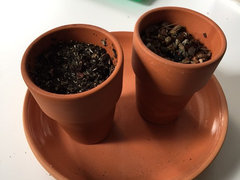
Interestingly, I just re-potted a burro's tail from another pot of the Bonsai Jack mix and it STANK at the bottom, like something rotten. The roots on the plant were still very shallow and nowhere near the bottom of the pot, but there was enough moisture still in the pot for pieces to stick to it and even a tiny puddle, even though I hadn't watered in at least 5 days. So, I'm thinking this mix may not be all it was cracked up to be.
Marlene (Zone 6b Boston, MA)
Original Author7 years agoRuss, if you are still open to it, I would LOVE to try a sample of your bark mix! I am emailing you now.
I've been re-reading some of the posts on the gritty mixes, and it seems like Al grows mostly bonsais and succulents (Al, care to chime in?). I'm wondering if they do have the same benefit for tropicals, which is what I mostly grow. Or, very likely, my store-bought gritty mix is not good enough.
Plants I have lost include a hoya, pepperomia, several succulents, and a croton (though that last suffered serious neglect for a few weeks at the hands of my husband, and never recovered). I've only ever used run-of-the-mill peat-based potting mixes, or "succulent mixes" for the succulents (though I've learned those mixes contained lots of peat.
My large Monstera a. is looking beautiful now! No more wilting or yellowing, and it's putting out new leaves. I'm watering it every 4-5 days. However, there is a funky smell coming from the bottom of the pot, and I'm concerned that the mix is getting foul as I noticed in my smaller pot that I mentioned. I would hate to disturb the plant right after it's recovered, but I'm definitely worried about what's going on with it.
And I love your idea of trying cuttings in different mixes!
Lauren (Zone 9a)
7 years agoMarlene,
the black and gold is a winner for sure. And yes, mine does seem to have more pumice! I actually strained some out for small plants.
I had an arrowhead that kept losing roots in normal soil and didn't do well in gritty mix. I put it in the black and gold with roots of barely an inch. Now, I have to repot it, the roots are so long. Within a month ! And the roots are strong and healthy and white.
for more water retention, I add a bit of cocopeat to it.
How's your monstera ?? Pics?
Russ1023 (central Fla)
7 years agoMarlene, I think Al also grows scheffleras and Ficus benjaminas.
Some succulent growers don't use any organic material in their mixes, using Turface instead as an ingredient that absorbs and holds moisture, along with several mineral aggregates. As with any mix, there are pros and cons.
Congrats on success with your monstera and stopping the yellowing leaves. On the funky smell, you might check the ingredients list on the bag of potting mix you used. If it has an organic fertilizer as an ingredient in it, such as fish meal, blood or bone meal, that could explain the odor. Many organic soil mixes use these types of natural fertilizers.
Lauren, good news that the Black and Gold mix was so successful in saving the arrowhead from certain death. Sounds like something you should stay with on your other plants.
Russ
Marlene (Zone 6b Boston, MA)
Original Author7 years agoLauren, you're using the C&S mix for your arrowhead?? Good to know!
I'll post new pics soon! It's dark and gloomy in here today because of rain so not a good day to show it off.
Russ, I checked the ingredients list and it ONLY contains pine bark fines, calcined clay, and Turface, no fertilizer is listed. The smell is a mystery! I can only assume that it's from water pooling at the bottom of the pot, as both affected pots had conical shapes and smaller drainage holes. I have a lot of vintage and decorative pots that I love, but I think I need to be more particular about using pots with large drainage holes.
Russ1023 (central Fla)
7 years agoMarlene, those ingredients are strange, Turface IS calcined clay. Maybe the calcined clay is ground up, but that would be new to me in potting soils. Bark and Turface is an odd mix by themselves, they both absorb and hold water.
I'm not sure water pooling at the bottom would create a foul odor unless something organic is rotting and I doubt it's the pine bark. Maybe the roots? If you unpot and check, I'd be interested to know what's going on with it.
Russ
Marlene (Zone 6b Boston, MA) thanked Russ1023 (central Fla)Marlene (Zone 6b Boston, MA)
Original Author7 years agoRuss, I have no idea what was causing the foul oder, the roots on the succulents were very shallow, nowhere near the bottom of the pot (as I had only planted them bareroot about 4 weeks before), and they looked healthy. The bottom of the pot is the only part that had the foul odor. This mix gets more dubious the longer we talk about it!
I just received your bark mixes - thank you! They led me to a question which I thought I would post here in case other newbies are reading. You said they will need to be moistened, "as is true with any dry potting soil." I had no idea that dry potting soil needs to be moistened??? Have I been doing everything wrong forever???
Lauren (Zone 9a)
7 years agoLol:). Hiya Marlene. It is standard practice to moisten the mix unless you are planting certain succulents or rooting succulent cuttings. But it sounds like you've been doing okay without doing that....
Russ1023 (central Fla)
7 years agoGlad you got the mixes Marlene.
Peat will act like talcum powder when dry, it rejects water and doesn't want to absorb it, ground pine bark acts similarly but not quite as bad.
Most commercial potting mixes using peat moss as a main ingredient will include a wetting agent which helps to rewet it if it dries out completely. But even with a commercial mix with wetting agent, it's best to dampen it anyway just to make sure there aren't pockets of dry mix in the pot. The commercial mixes that have a larger percentage of bark will rewet more easily since it's a crunchier mix with air spaces, but again it's best to moisten it before use.
I make my own mixes with raw ingredients and no wetting agent, so I MUST wet it down a bit in the bucket and stir it up. If I don't, and pot a plant with it, water will run thru the open paths it can find thru the mix, but most of the mix will be bone dry and the plant will have major issues.
Russ
Russ1023 (central Fla)
7 years agoMarlene, fill a pot with your commercial mix as if you were potting a plant and water it. After it drains, dump it out and see if there's any dry mix. Sometimes the wetting agent doesn't work very well.
A couple hundred years ago (the early 70's) I made my own Peat-Lite mixes that were popular in those days and noticed right away that peat moss repels water when it's bone-dry. Modern wetting agents help but don't always work.
Russ
Marlene (Zone 6b Boston, MA)
Original Author7 years agoOk, that's easy enough, thanks!
Pics of the recovered Monstera a.:

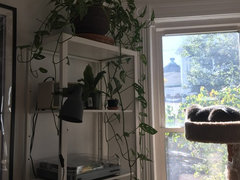


Russ1023 (central Fla)
7 years agoIt's doing great Marlene! Next year I'm going to put one against an oak tree and see how big the leaves get, it will always stay in immature stage when hanging.
Russ
Marlene (Zone 6b Boston, MA)
Original Author7 years agoThat sounds beautiful! It's a gorgeous plant for sure. Thank you guys for ALL your help!
Marlene (Zone 6b Boston, MA)
Original Author7 years agoMy Monstera a. has been yellowing again! It was looking good for months and then started turning sometime in January.
This time it's lots of leaves on lots of vines, plus more leaves with yellowed tips or a yellowish tinge. Is it time to look at the roots and see what's up?
As a refresher I have this plant in a store-bought Gritty mix that we were a little unsure of. It gets bright indirect light, that's a south-facing window, plus a few hours direct light on the lower/longer vines. I water about once a week.

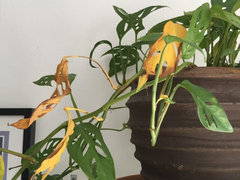

Lauren (Zone 9a)
7 years agoIt looks like uneven watering, or perhaps allowing it to get too dry before watering it.
Does the heat blow on it? That may be it, too.
my monstera had some yellow leaves too, and it came from allowing it to dry out for too long without watering. I took it down, gave it good thorough watering, and checked the roots.
you could, in any case, take a look at the roots and see how they are going just to be on the safe side.
Russ1023 (central Fla)
7 years agolast modified: 7 years agoPotting mix kept either too dry or too wet will cause the same yellowing of leaves. If the mix is still dark and moist-looking at the surface after your usual week, don't water. Wait until the soil is dry to a depth of an inch or so before watering.
On the other hand, if after the week you find that the soil is dry to a depth of over an inch or completely dry, you've waited too long to water. The latter could easily be the problem since you say it's in a 'gritty' mix and probably dries out fast. I don't consider this mix appropriate for a monstera, but it will adapt if you can get the watering figured out.
Russ
Lauren (Zone 9a)
7 years agoI second Ross on the mix. I think this plant would do much better in potting mix, maybe with some bark to give the roots room to breathe.
judging from the brown on the yellowed leaves and the shriveling, I am going to lean toward too dry for too long. Or, it may be sitting in water for too long, but that doesn't seem likely with the gritty mix.
But at this point, this plant should be thriving and putting out new leaves. It seems to be just surviving in the gritty mix.
tropicbreezent
7 years agoI also think checking the roots would be a good idea. Cold and dry isn't as big an issue as cold and wet. The roots will tell.
Marlene (Zone 6b Boston, MA)
Original Author7 years agolast modified: 7 years agoHi all,
Thanks so much for your responses!! I got sidetracked by a home reno I was working on but that's all finished now so I have time for plants again. I have not yet taken the monstera out of the pot and continues to have yellowing. I am making it a priority to peek at the roots this week, I'll let you know what I find!!
Lauren, I wanted to ask you again about your Black and Gold Cactus and Succulent mix. I know we talked about it a couple times and last fall you had good results with it for an arrowhead. How has the plant done in the meantime? Any other good or bad news with that mix? I'm thinking it might be a more appropriate medium for this monstera and I'm even considering it for a hart's tongue fern as those need superior drainage...
Lauren (Zone 9a)
7 years agoHi Marlene,
yes, my tropical s are still doing good in the black and gold mix:). If you are not opposed to peat, you could make a nice mix of peat and bark and perlite for your monstera. If it's still yellowing, that's not good.
when you unpot it, post a pic, and let others weigh on in on how to proceed. The black and gold mix is a good choice as well. But there are other options.
id get it out of that mix pronto and see how the roots look.
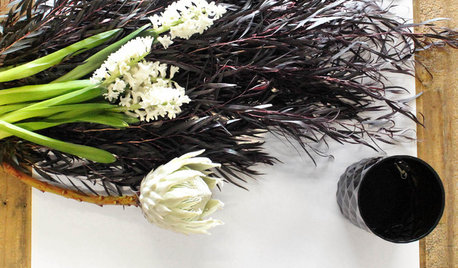
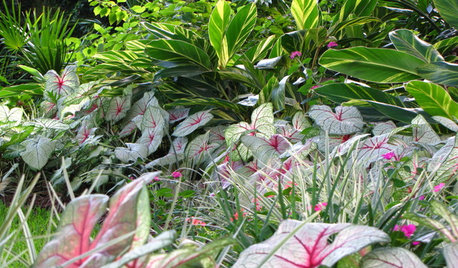
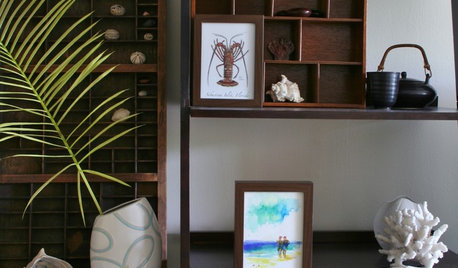







Russ1023 (central Fla)